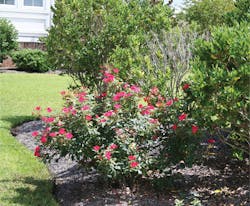Hydrant maintenance program keeps community safe, ensures unobstructed access to critical equipment
Do your customers know where the closest fire hydrant is to their homes? Are the neighborhood dogs the only ones who can sniff one out? Hydrants are often taken for granted or viewed as an eyesore or an inconvenience — until the time comes when we need them to be accessible.
Having timely, efficient access to a water supply is critically important for fighting fires. The longer it takes to access the supply, the quicker a fire can spread and the more dangerous it will be for responders. Obstructions cause unnecessary delays when firefighters are forced to take time to locate hidden hydrants, slowing their response.
Hydrant obstructions cause unnecessary delays for firefighters, slowing their response to a fire.
Brunswick Regional Water and Sewer (H2GO) crews experienced a literal growing problem around its community’s fire hydrants: Many of them were hidden by weeds, shrubbery, flowerbeds, posts, fences, and other obstructions. Today, H2GO works with local fire departments to ensure proper maintenance and operation of the more than 1,500 fire hydrants in its service area.
In June 2012, H2GO and the Leland Fire & Rescue Department implemented the Adopt-A-Hydrant program. The program was initiated in order to help residents in the district get involved in protecting their community. Residents were urged to check to see if they had a hydrant in their front yard or somewhere on their property line and were encouraged to “adopt” that fire hydrant and keep it free of vegetation, shrubbery, and other obstructions. The community served as a valuable resource to check whether a fire hydrant was clear of vegetation and structures.
Hydrants in H2GO’s service area were being hidden by weeds, shrubbery, flowerbeds, posts, fences, and other obstructions, making access difficult for fire crews.
Crews needed the area around a hydrant to be clear so they could perform maintenance and have easy access in the event of a fire. The community was able to help H2GO and the fire department in this mission by making sure adopted hydrants were easily accessible throughout the year. Some of the volunteers’ main roles included maintaining a path approximately three feet around the hydrant, ensuring a clear path from the street or roadway up to the fire hydrant, and ensuring the hydrant was visible and accessible.
However, even with the community volunteers, it was becoming a challenge to maintain hydrants under a growing canopy of vegetation. H2GO crews at times struggled to access some of the hydrants, which meant that the fire department wouldn’t be able to access them either. If that happened, residents and their homes would be at risk. So, the utility took action.
In June 2018, six years after the Adopt-A-Hydrant program was launched, H2GO’s Board of Commissioners passed a Fire Hydrant Obstruction Ordinance to help them in their mission to provide adequate access to hydrants. The newly adopted fire hydrant ordinance language requires a three-foot clear space to be maintained around the circumference of fire hydrants and other fire protection equipment. It limits the height of grass, plants or other objects within this three-foot radius to six inches. It further states that “no loose rocks or any other objects which may pose a tripping hazard shall be permitted within the foregoing radius and all fire hydrants and other fire protection equipment must have an unimpeded view range of at least two feet to each side along the roadway.”
A social media campaign included real photos of hidden fire hydrants from around H2GO’s service area and asked residents to find the hydrant using the hashtag #CanYouSpotTheHydrant?
This was the best way to ensure that H2GO’s team, as well as the fire department, had the clearest path to fire hydrants and that they would not be obstructed in the event of an emergency.
In addition to the new requirements, the ordinance also states that anyone violating it could be charged with a Class 1 misdemeanor. It also gives H2GO the right to remove the obstructions if the owner or HOA in charge does not comply with the ordinance.
In order to promote the new ordinance and better inform the community of the hazards of hidden fire hydrants, H2GO launched a month-long Fire Hydrant Safety campaign after the ordinance was introduced. It began with a press release to local media outlets informing them of the new ordinance and its requirements, as well as why it was necessary. H2GO also included a bill insert that gave residents important information about the ordinance.
The final part of H2GO’s campaign was a month-long social media effort, during which the utility posted facts about fire hydrants, the dangers of hidden fire hydrants, and language from the new ordinance. With each post, H2GO included real photos of hidden fire hydrants from around the community and used the hashtag #CanYouSpotTheHydrant? to spur engagement. One social media user even commented, “Uh, no, I can’t! That’s very disconcerting!”
The campaign worked. It effectively raised awareness within the community and the hydrant ordinance has allowed H2GO to be proactive in protecting the people and homes it serves.
About the Author: Tyler Wittkofsky is a Leland, North Carolina, native and a graduate of the University of North Carolina–Wilmington. Currently, he is the public information officer for H2GO and has spent the majority of his career working in public relations, ensuring a positive impact to the community for all organizations he has been with. He was named one of Brunswick County’s Future 10 in 2017 and the North Brunswick Chamber of Commerce’s Young Professional of the Year in 2018 for his passion for helping others discover the jewel that is Northern Brunswick County.
About the Author
Tyler Wittkofsky
Tyler Wittkofsky is a Leland, North Carolina, native and a graduate of the University of North Carolina–Wilmington. Currently, he is the public information officer for H2GO and has spent the majority of his career working in public relations, ensuring a positive impact to the community for all organizations he has been with. He was named one of Brunswick County’s Future 10 in 2017 and the North Brunswick Chamber of Commerce’s Young Professional of the Year in 2018 for his passion for helping others discover the jewel that is Northern Brunswick County.




